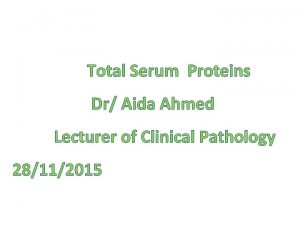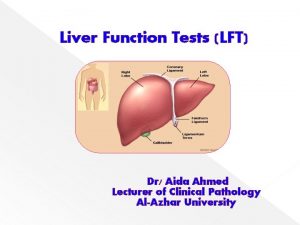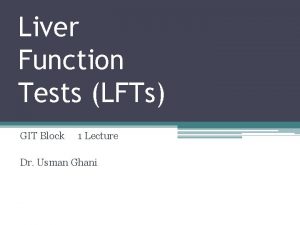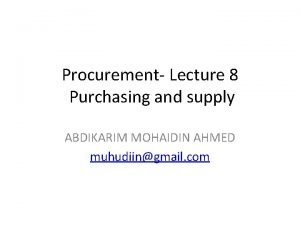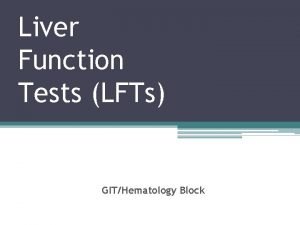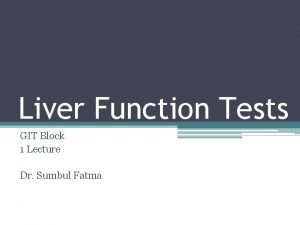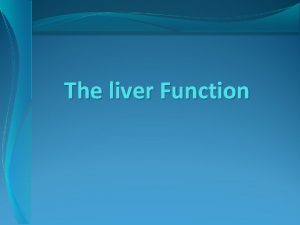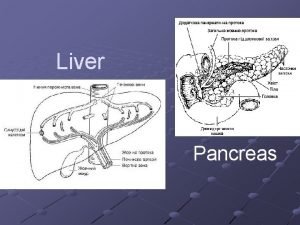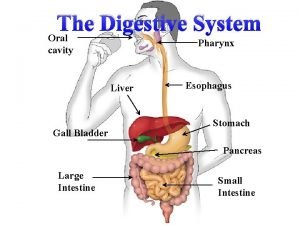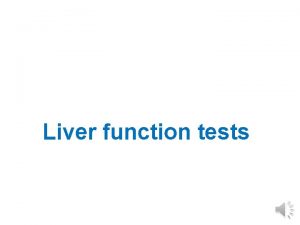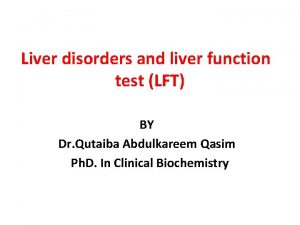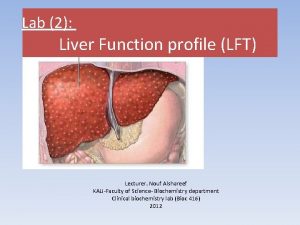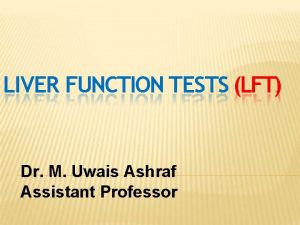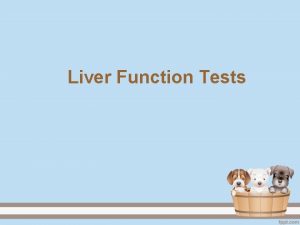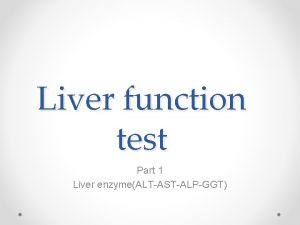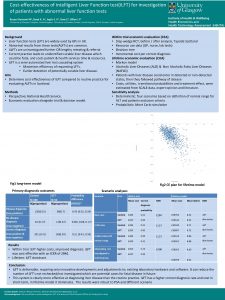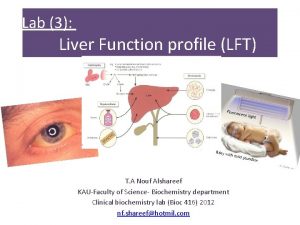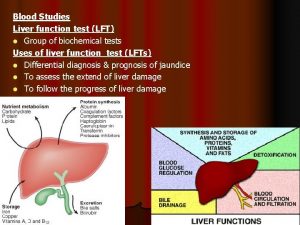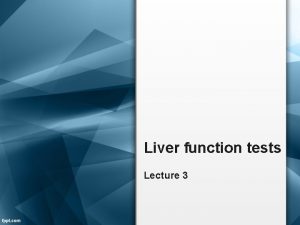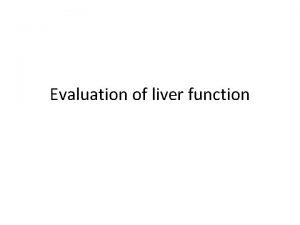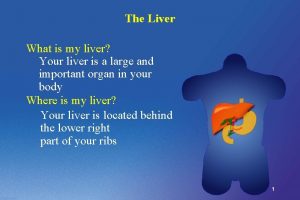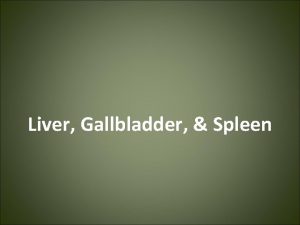Liver Function Tests LFT Dr Aida Ahmed Lecturer
































- Slides: 32

Liver Function Tests (LFT) Dr/ Aida Ahmed Lecturer of Clinical Pathology Al-Azhar University

Review: Liver � The liver is the largest organ in the body. � It is located below the diaphragm in the right upper quadrant of the abdominal cavity. � The working cells of the liver are known as hepatocytes.

� Liver regeneration can occur after surgical removal of a portion of the liver or after injuries that destroy parts of the liver. � , repetitive insults can produce liver failure & death.

Functions of liver � Metabolic � Liver function: actively participates in carbohydrate, lipid, protein, mineral & vitamin metabolisms. � Excretory � Bile function: pigments, bile salts & cholesterol are excreted in bile into intestine.

� Hematological function: � Liver participates in formation of blood (particularly in embryo) � Liver is also produces clotting factors like factor V, VII. � Fibrinogen involved in blood coagulation is also synthesized in liver. � It synthesize plasma proteins & destruction of erythrocytes.

� Storage function: � Glycogen, vitamins A, D & B 12 & trace element iron are stored in liver. � Protective function & detoxification: � Ammonia is detoxified to urea. � kupffer cells of liver perform phagocytosis to eliminate foreign compounds. � Liver is responsible for the metabolism of xenobiotics.

Bilirubin Production Hemoglobin (70 to 80%) Heme proteins myoglobin, cytochromes (20 to 25%) ferritin apoferritin Erythroid cells Heme (250 to 400 mg/day) 3 [O] Fe 3+ + CO Heme oxygenase Biliverdin NADPH + H+ Biliverdin reductase NADP+ albumin Bilirubin Indirect unconjugated pre-hepatic

Bilirubin Processing albumin-Bilirubin albumin ligandin-Bilirubin hepatocyte 2 UDP-glucuronate ER 2 UDP-Glucuronyl transferase Bilirubin diglucuronide bile (gall bladder) direct conjugated post-hepatic

Bilirubin Excretion Bilirubin diglucuronide liver 2 glucuronate Bacterial enzyme Bilirubin Intestines Intrahepatic urobilinogen cycle Bacterial enzyme Urobilinogen kidneys Urobilin Bacterial enzymes Stercobilinogen urine Feces

Plasma Bilirubin � Normal plasma bilirubin: 0. 2– 0. 8 mg/dl. � Unconjugated bilirubin: 0. 2– 0. 6 mg/dl. � Conjugated bilirubin: 0– 0. 2 mg/dl. � If the plasma bilirubin level exceeds 1 mg/dl, the condition is called hyperbilirubinemia. � Levels between 1 & 2 mg/dl are indicative of latent jaundice.

� When the bilirubin level exceeds 2 mg/dl, it diffuses into tissues producing yellowish discoloration of sclera, conjunctiva, skin & mucous membrane resulting in jaundice.

Bilirubin in urine � The conjugated bilirubin is water soluble & is excreted in urine. � The unconjugated bilirubin is not excreted.

� Major liver function tests may be classified as follows � Tests based on excretory function – Measurement of bile pigments, bile salts, � Tests based on serum enzymes derived from liver - Determination of transaminases, alkaline phosphatase, 5'-nucleotidase, γ – glutamyltranspeptidase.

� Tests based on synthetic functions – Prothrombin time, serum albumin. .

� Cholesterol mainly synthesized &metabolized in the liver � 70% estrified&30% free � Normal cholesterol 140 -240 mg/dl � Increased serum cholesterol in obstructive jaundice -Cholesterol total& estrified form decreased in chronic liver disease but increased in cholestasis or obstructive impaired metabolism jaundice due to

2. Serum enzymes � A large number of enzyme estimations are available which are used to ascertain liver function. � They are be divided into two groups: � Most commonly & routinely done in the laboratory. � AST & ALT

Aspartate transaminase (AST/SGOT) � AST or SGOT (serum glutamate oxaloacetate transaminase) SGOT

Aspartate transaminase (AST/SGOT) � Normal range: 10 -45 U/L. � AST is found in both cytoplasm & mitochondria � AST/GOT also reflects damage to the hepatic cells & is less specific for liver disease. � It can also be released with heart, muscle & brain disorders. � AST help diagnose various heart, muscle or brain disorders, such as a myocardial infarct (heart attack).

Elevated levels of AST may indicate � Acute hemolytic anemia � Cirrhosis of the liver � Hepatitis � Acute pancreatitis or inflammation of pancreas � Acute renal failure or loss of kidney function. � Heart attack � Primary muscle disease

Alanine transaminase (ALT/SGPT) � ALT or SGPT (serum glutamate pyruvate transaminase) � ALT is a cytoplasmic enzyme. � Normal Range: 5 -40 U/L. SGPT

Elevated levels of ALT/SGPT may indicate � Alcoholic liver disease � Cancer of liver � Hepatitis or inflammation of the liver � Noncancerous tumor of the liver � Use of medicines or drugs toxic to the liver � Cirrhosis or scarring of the liver � Death of liver tissue.

Alkaline phosphatase (ALP) � ALP occurs in in all tissues, especially liver, bone. bile duct, kidney & the placenta. � The ALP used to help diagnose certain liver diseases and bone disorders. � Normal range: 30 - 95 IU/L (3 -13 kings unit) Levels are significantly higher in growing children

� A rise in serum ALP (normal 3 -13 KA units/dl), usually associated with elevated serum bilirubin is an indicator of biliary obstruction (obstructive/posthepatic jaundice). � ALP is also elevated in cirrhosis of liver & hepatic tumors.

γ - Glutamyl transpeptidase (GGT) � This is a microsomal enzyme widely distributed in body tissues, including liver. � Measurement of γ - glutamyl transpeptidase (GGT) activity provides a sensitive index to asses liver abnormality. � The activity of this enzyme almost parallels that of transaminases in hepatic damage.

� Normal range: 10 -15 U/L � Serum GGT is highly elevated in biliary obstruction & alcoholism. � Several drugs (e. g. phenytoin) induce (liver synthesis) & increase this enzyme in circulation.

5'-Nucleotidase � Normal range: 2 -15 U/L � The serum activity of 5'-nucleotidase is elevated in hepatobiliary disease & this parallels ALP. � The 5'-nucleotidase is not altered in bone disease (as is the case with ALP).

4. Synthetic function � Serum albumin: � Albumin is solely synthesized by the liver. � It has a half-life of about 20 -25 days. � It is a good marker to assess chronic (& not acute) liver damage. � Low serum albumin is commonly observed in patients with severe liver damage. � Albumin is also decreased in malnutrition.

� Functional impairment of liver is frequently associated with increased synthesis of globulins. � Cirrhosis of the liver causes a reversal of albumin/globulin ratio (A/G ratio). .

Prothrombin time � The liver synthesizes all the factors concerned with blood clotting. � A decrease in the concentration of plasma clotting factors is found in the impairment of liver function. � Prothrombin time is prolonged in patients with liver damage, compared to normal. � It generally falls 10 - 15 seconds.

INTERPRETATION OF LIVER FUNCTION TESTS

Typical LFT profile in hepatocellular disease Typical LFT profile in cholestatic jaundice Marked elevation of AST and ALT (usually >500 IU) Marked elevation of ALP (>3 times normal) Mild increase of ALP (<3 times normal Elevation of GGT and 5'Nucleotidase Mild or no increase of ALT and AST (usually <200 IU). . Hyperbilirubinemia, if present, is of both conjugated and unconjugated type Elevation of conjugated bilirubin

Thank you
 Lecturer's name or lecturer name
Lecturer's name or lecturer name Aida ahmed
Aida ahmed Ggt normal range
Ggt normal range Ubg github
Ubg github Ahmed muhudiin ahmed
Ahmed muhudiin ahmed Ace different tests help iq still
Ace different tests help iq still How to calculate slack in project management
How to calculate slack in project management Total float= * 1 point lst-est lst-eft est-lft eft-lst
Total float= * 1 point lst-est lst-eft est-lft eft-lst Laboratory hood accessories
Laboratory hood accessories Float activity
Float activity Art 474 lft
Art 474 lft Normal lft
Normal lft Ggt normal range
Ggt normal range Normal globulin levels
Normal globulin levels Lft profile
Lft profile Jeannie watkins
Jeannie watkins Spe distinguished lecturer
Spe distinguished lecturer Good afternoon teacher
Good afternoon teacher Photography lecturer
Photography lecturer Lecturer in charge
Lecturer in charge Designation lecturer
Designation lecturer Designation of lecturer
Designation of lecturer Guest lecturer in geography
Guest lecturer in geography Lecturer name
Lecturer name Pearson lecturer resources
Pearson lecturer resources Spe distinguished lecturer
Spe distinguished lecturer Lector vs lecturer
Lector vs lecturer Lecturer in charge
Lecturer in charge Cfa lecturer handbook
Cfa lecturer handbook Lecturer asad ali
Lecturer asad ali Gilbert syndrome
Gilbert syndrome Liver and pancreas function
Liver and pancreas function Pharynx in digestive system
Pharynx in digestive system

